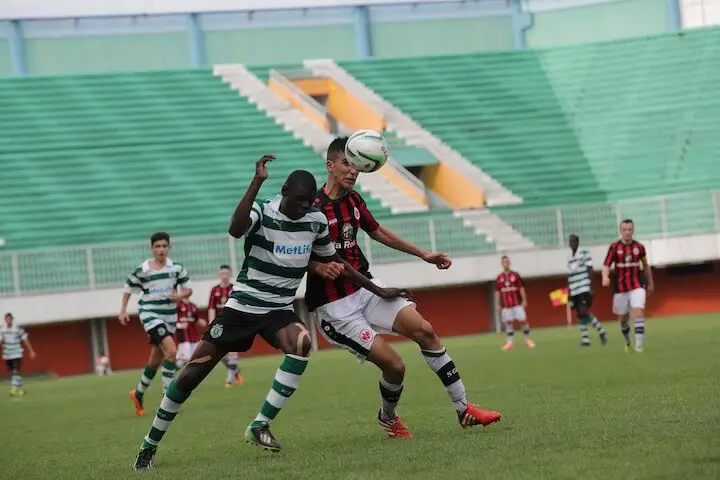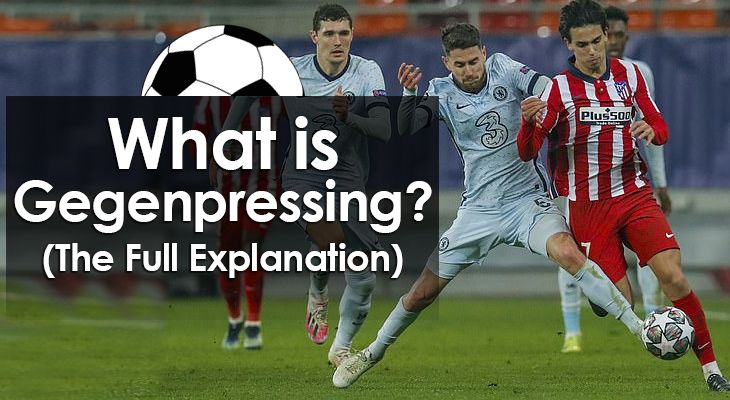What is Gegenpressing? (The Full Explanation)
Gegenpressing is basically the German version of the term “counter-pressing”.
For people who know what the term means in soccer, it’s fairly obvious how the name ties in.
The counter-pressing style of play has a long history of use in modern soccer, but we can trace its roots back to the earlier years of the game.
At the time, there wasn't enough global coverage of league soccer to make the style popular enough, and there were long periods where it seemed altogether out of use.
Considering the relatively huge (and mostly positive) acclaim that gegenpressing has in the game today, we decided to take a look at its history and how the style has been reinvented over the years by some of soccer’s best coaches.
The Background of Gegenpressing
For casual soccer fans, there's a general belief that the style was created by German coach, Jurgen Klopp.
But this couldn't be further from the truth.
Jurgen Klopp’s Mainz side of the 2000's did dabble in gegenpressing, and it became his go-to style of play when he moved to Borussia Dortmund. In fact, it was arguably his time at Dortmund that really brought the style back to the public, mainstream eye.
However, he didn't invent the style.
He simply modified an existing philosophy to suit the team that he had.
The real background of gegenpressing goes further back to English soccer in the 1960's.
It spread further to the Netherlands, where teams such as the Dutch national side and Rinus Michels’ Ajax implemented a pressing system in their total football approach.
The Influence Of Arrigo Sacchi’s Milan
As the game changed further, the pressing system spread to Italy.
In the late 1970s, the idea of gegenpressing really began to solidify -- with Arrigo Sacchi.
At the time, the Italian Serie A was becoming increasingly difficult for teams that liked to dominate play. Italian clubs were developing their tactics around low blocks that were incredibly hard to penetrate, and the average number of goals scored per game dropped to under 1.9 per game.
Arrigo’s response with his Milan team was to integrate a pressing system where his team immediately closed down the opponent whenever they lost the ball -- especially in the attacking third.
He found that winning possession back higher up the pitch was the best way to create a weakness in the low blocks and create scoring chances before the opponent had time to recover.
Since then, many other managers have tried to modify the system in their own way too, with varying degrees of success.
A couple of notable examples include Ralf Ragnick’s RB Leipzig team, Jurgen Klopp’s Dortmund and Liverpool teams, and Julian Nagelsmann’s Hoffeinheim and RB Leipzig teams.

Gegenpressing, Tiki-Taka, and Total Football
At this point, it's important to learn the difference between “pressing” and “gegenpressing”.
This will help to understand how the teams that played total football or tiki-taka vary from those that play gegenpressing, despite both styles being very similar in the defensive phases of play.
Pressing is an aspect of play that is crucial to the success of all three styles:
- Total Football
- Tiki-Taka
- Gegenpressing
It refers to the immediate response of trying to win the ball back once a player loses possession.
This is based on the ideology that the opponent is most vulnerable right after winning possession as they try to figure out their next move.
At that point, the defenders can immediately swarm the opposition to try and win it back.
The key difference between these three styles of play is what happens in the build-up / attacking phases of play.
a. Tiki-Taka
The tiki-taka system favors a patient, slower build-up.
It involves a lot of short passing designed to wear the opponent out and cause them to lose concentration positionally.
b. Total Football
Similarly, total football also relies on a more patient approach, but in contrast to the focus on the movement of the ball with tiki-taka, total football focuses more on the movement of the players.
There's a very flexible approach to the way player positions are viewed in build-up / attacking phases of play, which places emphasis on the versatility of the personnel playing the style.
One might say tiki-taka is an evolution of total football -- in a good way.
c. Gegenpressing
Where pressing is just an aspect of a tactical setup, gegenpressing is a whole system in itself.
Gegenpressing adopts a higher intensity approach to play.
When the team wins possession, the players keep up the tempo and immediately look to break away and create goal-scoring chances.
Players try to do this before the opponent can reorganize for another attempt to win the ball back.
How Does Gegenpressing Work?
"Gegenpressing lets you win back the ball nearer to the goal. It's only one pass away from a really good opportunity. No playmaker in the world can be as good as a good gegenpressing situation, and that's why it's so important."
Those are the words of Jurgen Klopp, and it's easy to tell how much he favors the gegenpressing style of play from that quote alone.
Also, it's perhaps the best way to describe how the system works as concisely as possible.
For further context, we can use an example of one of the teams of the man himself...
The Liverpool team of the English Premier League.
Jürgen Klopp’s Gegenpress
Currently, Liverpool plays with a frontline of three players, two of which are wingers (Mohamed Salah and Sadio Mane) acting as inside forwards, which means that they can often be found coming into central areas of the opponent’s 18-yard box.
The space vacated by the inside forwards on the wings allows the full-backs to push forward as often as possible, while the defensive midfielder drops into defense to ensure that the opponent can not overload the center-backs in the absence of the full-backs.
This means that the team will often find itself in situations where they have at least five players in the attacking third of the pitch, and that strength in numbers allows them to press the opponent with an overload if possession is lost in that area.
In the gegenpressing system, these numbers are needed to form clusters that close down a player in possession, rapidly limiting the player’s options for progressing the ball and often forcing them into a mistake.
When that happens, the strength in numbers again shows as the team immediately looks to break away and attack the opponent’s goal with speed and efficiency.
With Klopp’s take on the system, the team mostly presses in certain “low-risk” areas of the pitch.
For instance, the example of pressing in the attacking third presents a low-risk situation for the team because even if the press fails, the players still have time to recover defensively without giving up a good counter-attacking chance for the opponent.
In a high-risk area such as the defensive third, players may still close down an opponent two at a time, but the defense as a whole is set up to regroup and be compact rather than counter-press.

3 Successful Gegenpressing Teams
Sticking to more recent instances of teams that have achieved a respectable amount of success with the gegenpress system, these three comes to mind:
a. Liverpool
The most recent example of a successful gegenpressing side. Jurgen Klopp’s Liverpool team enjoyed a good period of success playing the system.
When the German manager joined the club, they were closer to mid-table than the top of the league. A few years later, they had been to the Champions League final twice and won it once.
They also won the league title, the UEFA Super Cup, and the Club World Cup trophy.
b. Borussia Dortmund
This was, again, an example of just how effective the gegenpress system has been for Jurgen Klopp in his career as a manager.
Similar to his time at Liverpool, he had the odds stacked against him here in a league absolutely dominated by Bayern Munich.
Yet, somehow, they won back-to-back league titles playing with the gegenpress system and came painfully close to winning the Champions League too.
c. Bayern Munich
Winning the league title is not particularly a special event for Bayern Munich, but a combination of other considerations made this period with Jupp Heynckes stand out.
In the 2012/13 season, Bayern Munich won it all playing the gegenpress system with Heynckes. They won the league title, the Champions League, the Super Cup, and the German Cup.
They won 46 of 54 games that season, losing only three for a ridiculous average of 2.65 points per game.
Conclusion
As you should be able to tell at this point, it's hard to attribute the invention of the gegenpress system to one particular person.
We can all agree that the evolution of pressing was a key component of the rise of the system, but there have been so many tweaks and adjustments from various coaches that it appears there is not even one lone style of gegenpress.
If there is one thing that we do know, it's that as far as modern tactics go, the gegenpress remains one of the most revolutionary systems out there.

